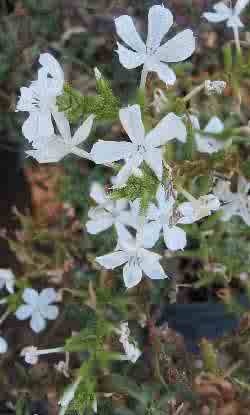Plumbago scandens

Common: White plumbago, White desert plumbago, Doctorbush, Summer Snow, Leadwort
Family: Plumbaginaeae
Origin: Florida to Arizona south to Central America
Light: Best in light shade to full sun
Water: Regular
Temp: Prefers some shade in the low deserts
Soil: Most soils
Evergreen shrub to 4 feet or more tall and wide. Blooms year-round with short break during hottest part of summer.
Flowers floxlike clusters of white, sometimes with blue tinge 1 inch wide. They are particularly striking when they appear in combination of red leaves.
Oblong lanceolate leaves to 4 inches long are deep red when new maturing to medium green; nearly all foliage turns red again in late fall and winter
Valuable for striking color display, long flowering period and winter color.
Plumbago is visited by butterflies and is one of the larval foods plant for the common blue butterfly (Cyclyrius pirithous) which is apparently fairly common in gardens as a result of the popularity of plumbago as a garden plant.
Children often make "earrings" with the sticky flowers - letting them stick to their earlobes. There are sticky, gland tipped hairs on the flower calyx. The seed capsule retains the stickiness which presumably helps disperse the seed by attaching to animals. The top of the capsule splits opens and drops the seed out.
Plumbago is used traditionally to treat warts, broken bones and wounds. It is taken as a snuff for headaches and as an emetic to dispel bad dreams. A stick of the plant is placed in the thatch of huts to ward off lightning.